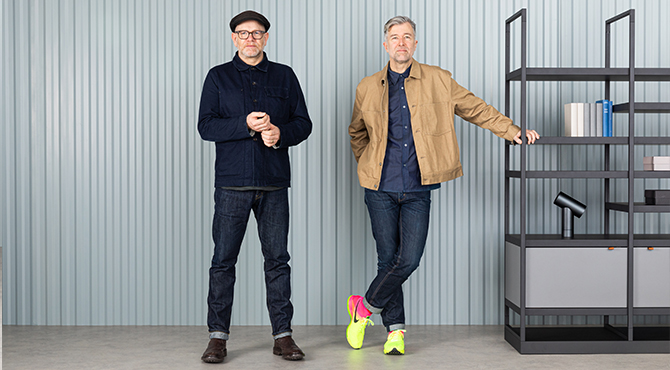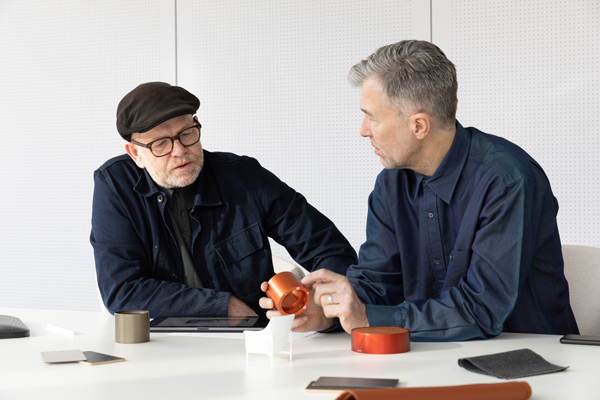
Time and again, the two design partners from London impressively demonstrate what high-quality industrial design is all about, namely cleverly transposing changing ways of working and life situations to new products and usage concepts. 10 years after the joint development of the PARCS product series, the London design studio PearsonLloyd has once again developed an innovative office concept together with Bene: PORTS.
We spoke to Tom Lloyd and Luke Pearson about the evolution from “New Working Environments” to “New Leadership Environments” and thereby developing PORTS.

How would you describe the difference between management and leadership?
Luke Pearson: For me, leadership is more about creative guidance, and managing is perhaps more about logistics and the practicalities.
Tom Lloyd: For me, management is about the day to day running of a business. It follows routines, practices and policies; it is largely a reactive process.
Leadership is proactive. It is the ability to respond to a crisis, plan for the future, be entrepreneurial, inspire, look after your team, motivate. It is what makes a business succeed or fail.
What does ‘new leadership’ mean for you?
Luke Pearson: I think one of the differences in new leadership for me is a greater up-flow of information and ideas. This does not diminish the need for leadership, but it makes the process more inclusive and therefore, in my opinion, more rigorous.
Tom Lloyd: There are two answers to this question.
In many ways, the needs of leaders have not changed at all for generations. Their days mix private concentrated work with different forms of interaction - with clients, peers and staff. They still need to have as much time and space as possible in which to plan the performance of their duties, manage their stress levels, think creatively, and look to the future. They still aspire to environments that are of the best quality.
At the same time, organizations are becoming less overtly hierarchical. The spatial provision of organizations is breaking down. The private office is slowly disappearing. Leaders are becoming more open, collaborative, and democratic. They are also getting younger.
Leaders still need to be looked after and cherished, they still need privacy, quality, and to manage stress and work overload.
What is special about a New Leadership office?
Tom Lloyd: A real reinterpretation of what a Leadership Office looks like and how it performs.
Luke Pearson: The New Leadership office is a dynamic place and an unpredictable one because the conventional signals that say ‘leader’ are no longer necessary in the same way. What we need now are truly intelligent spaces that promote dialogue and focus. For this reason, PORTS layout flexibility will make it highly applicable.
What was the initial motivation for the project idea?
Luke Pearson: PORTS really came out of a continued research into the broader context of people and relationships within the office and a breaking down of traditional hierarchical boundaries.
Tom Lloyd: Since 2007 we have been working with Bene in search of new ways of interpreting the workplace. Since then, new ideas have emerged every year in our search for better and more effective working environments. Throughout these developments, we noticed that little of this thinking was being used to consider how senior leaders can better be supported in their work. ‘Management’ furniture seems stuck in a traditional status-driven style with little attempt to think creatively about what leaders need and how their work can also be enhanced. This was the starting point for PORTS; how could we apply the same thinking that generated PARCS to new environments for leaders?
Who did you design PORTS for?
Luke Pearson: PORTS has been designed for leaders, but in our view supports a far more integrated and democratic working environment.
Tom Lloyd: Everyone. Above all people in positions of responsibility within organisations, but in fact, anyone who needs time and space to think, organise, retreat, in an atmosphere that encourages clear thinking. PORTS is also a place for collaboration, a place to communicate easily – talk, speak, present, discuss, plan, create.

Was PORTS created for the office only?
Luke Pearson: I see PORTS as at home in a hotel lobby, airport lounge or office. Conventional work boundaries will continue to emerge as new technologies make our working life more blended.
Tom Lloyd: No – the needs that PORTS responds to and the experience that we have been seeking to create is just as relevant in hospitality and transport spaces. The world of work has become more and more distributed, and technology has transformed the way we connect to our world. Today we really do work wherever we happen to be.
What makes PORTS so special?
Luke Pearson: PORTS has embedded smarts. I like the dynamic and postural change that the different items support. Most of the functions are very discrete, and until you discover them, are really not noticeable.
Tom Lloyd: The market for management space and furniture is still defined by hierarchy and old ideas of status, with no sense of what the user needs; it has not changed for over a century. PORTS seeks to redefine what a private work space looks like and how it works.
What does the PORTS product family consist of?
Luke Pearson: PORTS conists of three elements: A shelving system, a table and a functional lounge furniture collection.
The flexible shelf unit, in which personal storage space and space for technology is available, also fulfills a double role as a room divider.
The height-adjustable rise and fall table is optically very simple, but the subtleties lie in the details.It’s a 4-leg table with a height adjusting motor in each leg, which means it has a very light and minimal structure. It becomes a piece of furniture again when most of these creations look like complex machines.
The Task Lounge is a lounge chair with a unique tilting seat pan to allow relaxed reading and reclined work, but when activated, it places the user in a much more upright posture for laptop work. The unit is suited with a screen and laptop table which provides multiple positions, allowing lots of different settings to be created. The support structure is a screening element, meaning the chair can be placed in the open but provides a degree of privacy.
The lounge chair and sofa collection really flows out of the Task Lounge Chair, these elements are in many ways very conventional lounge chairs and sofas. However, should not be missing in modern office landscapes and are the perfect addition to the product family.

Tom Lloyd: Three separate product collections working together in harmony - creating informal, private, and collaborative open work spaces.
What is the connecting aspect between PARCS and PORTS?
Luke Pearson: In many ways, PORTS is an extension of the thinking that led to PARCS. Both projects are about facilitating good communication. Clearly, PORTS has an emphasis on leadership scenarios which has both a personal focus, but also allows for intimate work settings, and as such it is dynamic and flexible so that it can change from a single person (leader) to a group setting very quickly. There is a lot of postural change possible.
Tom Lloyd: Both PARCS and PORTS challenge the archetype. They are both research led, both risk-taking, and both deliver transformative innovation. They create informal, expressive, inspiring, and enjoyable spaces.